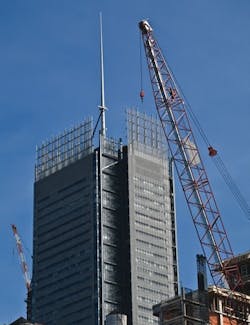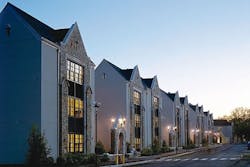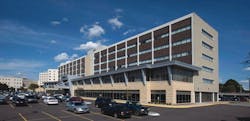Newsworthy
Save Money with New Commercial Buildings Tax Deduction
On Oct. 3, 2008, former President Bush signed HR 1424 into law and extended the Energy Efficient Commercial Buildings Tax Deduction as part of the Emergency Economic Stabilization Act of 2008. If you have retrofitted your building to be more energy efficient, you may be eligible for a deduction for part or all of the costs associated with an installation or retrofit. This opportunity allows for the potential immediate expensing of costs that would otherwise be capitalized and recovered through depreciation over 27.5 or 39 years.
Doug Morrell, marketing director at Ft. Worth, TX-based SourceCorp, explains the law and how it can help you save money in these tough economic times.
Buildings: How will HR 1424 help commercial building owners?
Morrell: The Commercial Buildings Tax Deduction (CBTD) gives owners a tax benefit of as much as $1.80 per square foot for qualifying energy-efficiency improvements, effectively lowering the investment required to build green or update or replace outmoded systems. The return - in the forms of utility-bill savings and accelerated tax deductions - creates a genuine financial incentive at a time when building owners could really use one.
Buildings: What sorts of energy-efficient retrofits will qualify buildings for this deduction?
Morrell: The Energy Policy Act of 2005 includes a tax deduction for energy-efficient building systems designed for 50-percent energy cost savings relative to a building designed within the scope of ASHRAE 90.1-2001 - Energy Standard for Buildings Except Low-Rise Residential Buildings. The deduction is limited to $1.80 per square foot of the property, with allowances for partial deductions for improvements in interior lighting, HVAC and hot-water systems, and building-envelope systems.
Buildings: Is it too late to implement these retrofits in order to seek the deduction?
Morrell: No. The deduction is allowed for property placed in service after Dec. 31, 2005, and prior to Jan. 2, 2014.
Buildings: Where can our readers go for more information?
Morrell: Additional information on tax incentives and other cost-savings measures can be found online.
Skyscraper Work Stopping
According to Darmstadt, Germany-based Emporis Corp., work on skyscrapers (buildings at least 328-feet tall) has stopped on 8.7 percent of tall buildings already under way worldwide.
In the United States, 10.3 percent of skyscrapers under construction have been put on hold. Australia and Asia are also suffering from a worse-than-average stoppage rate. Before the real estate crisis in the United States, the only skyscraper known to have been put on hold in the United States or Europe more than 6 months ago is Met 1 in Miami.
University of Oregon Will Upgrade Physical Plant
The physical plant at the University of Oregon, Eugene, OR, which provides heating, cooling, and some electricity to almost every building on campus, is set to be upgraded. The project will boost the capacity of the campus utility system while shrinking the school's carbon footprint.
Once upgraded, the facility will provide more steam and electricity at less cost and greater efficiency. The first part of the project - a new chiller plant - began in December and will take 1 year to complete. The project also includes improvements to building electrical systems and a new electricity substation.
A second phase of the project is in the initial design phase, and could include the replacement of 1950s-era boilers originally heated by sawdust left over from lumber production. If all phases are approved and accomplished, the upgrade project will cost more than $80 million.
Student Housing Refreshed at St. John's University
A new, 66,000-square-foot dormitory recently opened at St. John's University in Queens, NY. Welcoming nearly 300 students for the Fall 2008 semester, the dorms were designed by New York City-based Stonehill & Taylor Architects and Planners. While adding a modern touch to campus, the new dormitory integrates with the university's existing Gothic architecture through arched entryways and Weymouth granite.
The design consists of a series of townhouse-style, 3-story structures situated around U-shaped courtyards. Each apartment houses seven students and includes bedrooms that maximize sunlight and views, a full kitchen, and a living room. Moving away from the impersonal, corridor-oriented structures that are common to many college campuses, the new dorms have a neighborhood feel that supports community among students.
More FMs Taking Strategic Approach to Green
According to a recent study by the Houston, TX-based Intl. Facility Management Association (IFMA), facility managers are increasingly following master plans when implementing green practices, sticking to measurable goals and business strategies. The study, Green Practices 2008, reveals that, while recycling and energy-conservation initiatives are being practiced by most facilities professionals, financial challenges still present the biggest impediment to going green.
Based on survey results from 573 professionals from around the globe, the report examines the forces behind sustainability and green practices, and the problems in implementing sustainable initiatives. Most survey respondents say they are implementing green-building concepts without a master plan, but 17 percent say they are adhering to one - an increase of 9 percent since 2002. Remarkably, 92 percent of respondents say they're working to make their facilities more sustainable; the same percentage say they have measurable goals related to sustainability.
"For years, facility managers have been advancing sustainable practices with the aim to lower operating costs and improve efficiency," says Shari Epstein, director of research at IFMA. "This study demonstrates the gradual shift toward incorporating sustainability into overall business strategy, in addition to the overall design and operation of the facility."
Classroom Acoustics Impact Learning
The Washington, D.C.-based United States Access Board recently conducted a roundtable to explore ways of improving acoustics in classrooms. The event featured presentations on acoustical standards, as well as discussions focused on efforts to promote classroom acoustical design and the use of standards through research, coordination with model building code groups and other stakeholders, and congressional or rulemaking initiatives.
Poor classroom acoustics impact learning for all children, but the effects are pronounced for those with permanent or temporary hearing loss, those with speech or learning impairments, those who use cochlear implants, and non-native speakers of English. A voluntary standard, Acoustical Performance Criteria, Design Requirements and Guidelines for Schools, has made some progress in classroom acoustics, and has been adopted by a growing number of states, local jurisdictions, and boards of education.
Credit Crunch Not Likely to Affect Green Building
Despite concerns about the availability of credit, 75 percent of commercial real estate executives surveyed by New York City-based Turner Construction Co. said they would not be any less likely to construct green buildings. Turner's 2008 Green Building Market Barometer survey shows that green buildings are viewed as having lower energy, operating, and life-cycle costs, as well as higher building values, asking rents, and occupancy rates.
Survey participants were also asked about LEED certification. Although 54 percent of executives noted that the cost of LEED documentation is an "extremely" or "very significant" obstacle to green construction, 83 percent still said they would be "extremely" or "very likely" to seek LEED certification if they were planning to build within the next 3 years.
1950s Medical Office Building Transformed
The Southdale Medical Building's healthcare facility in Edina, MN, has been transformed from a 1950s medical office building into an expanded, modern medical facility. Softening the sharp, sterile edges of the 6-story building, Minneapolis-based KKE gave the building an inviting curtainwall entry and a winged roof that enhance the visibility of the 26,000-square-foot, 2-story addition.
Built on a tight schedule, the medical center's main façade is clad in Minnesota limestone. Composite aluminum panels, tinted vision glass, and matching spandrel glass complete the exterior. A substantial roof overhang and supporting structure shade the west-facing glass from afternoon sun, and the materials were selected for long-term sustainability. Inside, a comfortable lobby is the inviting focal point of the multi-phase structure.
Challenges faced during construction included minimizing disruption to existing medical clinics, some of which were extremely sensitive to noise and vibration. According to Todd Young, principal and designer at KKE, "Issues, such as structural attachment of the addition to the existing building, needed special attention, as did exiting and life safety for non-ambulatory patients during construction. An extraordinary level of planning, in consultation with building officials and medical professionals, was required and achieved."
Renewable Energy Action Team Formed in California
California Governor Arnold Schwarzenegger recently signed an executive order to streamline the state's approval process for renewable-energy projects. Executive Order S-14-08 requires a "one-stop" permitting process to be created by the California Energy Commission and the California Department of Fish & Game.
The new team, called the Renewable Energy Action Team, will indentify priority areas in California for renewable-energy development and will start a planning process to allow appropriate development in those areas, while still protecting habitats and species. The process will first be applied to the Mojave and Colorado Desert regions, where large solar-power projects are under construction.




